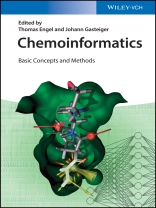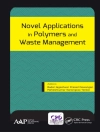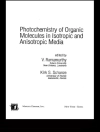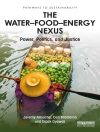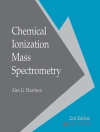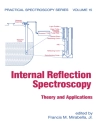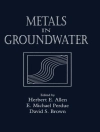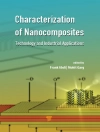This essential guide to the knowledge and tools in the field includes everything from the basic concepts to modern methods, while also forming a bridge to bioinformatics.
The textbook offers a very clear and didactical structure, starting from the basics and the theory, before going on to provide an overview of the methods. Learning is now even easier thanks to exercises at the end of each section or chapter. Software tools are explained in detail, so that the students not only learn the necessary theoretical background, but also how to use the different software packages available. The wide range of applications is presented in the corresponding book Applied Chemoinformatics – Achievements and Future Opportunities (ISBN 9783527342013). For Master and Ph D students in chemistry, biochemistry and computer science, as well as providing an excellent introduction for other newcomers to the field.
สารบัญ
Foreword xxi
List of Contributors xxv
1 Introduction 1
Thomas Engel and Johann Gasteiger
1.1 The Rationale for the Books 1
1.2 The Objectives of Chemoinformatics 2
1.3 Learning in Chemoinformatics 4
1.4 Outline of the Book 5
1.5 The Scope of the Book 7
1.6 Teaching Chemoinformatics 8
References 8
2 Principles of Molecular Representations 9
Thomas Engel
2.1 Introduction 9
2.2 Chemical Nomenclature 11
2.2.1 Non-systematic Nomenclature (Trivial Names) 11
2.2.2 Systematic Nomenclature of Chemical Compounds 12
2.2.3 Drawbacks of Chemical Nomenclature for Data Processing 12
2.3 Chemical Notations 12
2.3.1 Empirical Formulas of Inorganic and Organic Compounds 12
2.3.2 Line Notations 14
2.4 Mathematical Notations 14
2.4.1 Introduction into Graph Theory 15
2.4.2 Matrix Representations 18
2.4.2.1 Adjacency Matrix 18
2.4.2.2 Incidence Matrix 19
2.4.2.3 Distance Matrix 20
2.4.2.4 Bond Matrix 21
2.4.2.5 Bond–Electron Matrix 21
2.4.2.6 Summary on Matrix Representations 23
2.4.3 Connection Table 23
2.5 Specific Types of Chemical Structures 25
2.5.1 General Concepts of Isomerism 25
2.5.2 Tautomerism 26
2.5.3 Markush Structures 27
2.5.4 Beyond a Connection Table Representation 28
2.5.4.1 Representation of Molecular Structures by Electron Systems 28
2.6 Spatial Representation of Structures 31
2.6.1 Representation of Configurational Isomers 32
2.6.2 Chirality 33
2.6.3 3D Coordinate Systems 36
2.7 Molecular Surfaces 37
Selected Reading 38
References 393
3 Computer Processing of Chemical Structure Information 43
Thomas Engel
3.1 Introduction 43
3.2 Standard File Formats for Chemical Structure Information 44
3.2.1 SMILES 44
3.2.1.1 Stereochemistry in SMILES 47
3.2.1.2 Summary on SMILES 47
3.2.2 SMARTS 47
3.2.3 SYBYL Line Notation 48
3.2.4 The International Chemical Identifier (In Ch I) and In Ch IKey 48
3.2.5 XYZ Format 50
3.2.6 Z-Matrix 51
3.2.7 The Molfile Format Family 52
3.2.7.1 Structure of a Molfile 53
3.2.7.2 Stereochemistry in the Molfile 57
3.2.7.3 Structure of an SDfile 57
3.2.8 The PDB File Format 58
3.2.8.1 Introduction/History 58
3.2.8.2 General Description 58
3.2.8.3 Analysis of a Sample PDB File 60
3.2.9 Metadata Formats 65
3.2.9.1 STAR-Based File Formats and Dictionaries 65
3.2.9.2 CIF File Format 66
3.2.9.3 mm CIF File Format 67
3.2.9.4 CML 68
3.2.9.5 CSRML 68
3.2.10 Libraries for Handling Information in Structure File Formats 69
3.3 Input and Output of Chemical Structures 70
3.3.1 Molecule Editors 72
3.3.2 Molecule Viewers 73
3.4 Processing Constitutional Information 73
3.4.1 Structure Isomers and Isomorphism 73
3.4.2 Tautomerism 74
3.4.3 Unambiguous and Biunique Representation by Canonicalization 76
3.4.3.1 The Morgan Algorithm 77
3.4.4 Ring Perception 79
3.4.4.1 Introduction 79
3.4.4.2 Graph Terminology 80
3.4.4.3 Ring Perception Strategies 81
3.5 Processing 3D Structure Information 86
3.5.1 Detection and Specification of Chirality 86
3.5.1.1 Detection of Chirality 87
3.5.1.2 Specification of Chirality 87
3.5.2 Automatic Generation of 3D Structures 90
3.5.3 Automatic Generation of Ensemble of Conformations 94
3.6 Visualization of Molecular Models 100
3.6.1 Introduction 100
3.6.2 Models of the 3D Structure 101
3.6.2.1 Wire Frame and Capped Sticks Model 101
3.6.2.2 Ball-and-Stick Model 101
3.6.2.3 Space-Filling Model 102
3.6.2.4 Crystallographic Models 102
3.6.3 Models of Biological Macromolecules 102
3.6.4 Virtual Reality 103
3.6.5 3D Printing 103
3.7 Calculation of Molecular Surfaces 103
3.7.1 Van der Waals Surface 104
3.7.2 Connolly Surface 104
3.7.3 Solvent-Accessible Surface 105
3.7.4 Enzyme Cavity Surface (Union Surface) 106
3.7.5 Isovalue-Based Electron Density Surface 106
3.7.6 Experimentally Determined Surfaces 106
3.7.7 Visualization of Molecular Surface Properties 107
3.7.8 Property-based Isosurfaces 107
3.7.8.1 Electrostatic Potentials 108
3.7.8.2 Hydrogen Bonding Potential 108
3.7.8.3 Polarizability and Hydrophobicity Potential 108
3.7.8.4 Spin Density 108
3.7.8.5 Vector Fields 108
3.7.8.6 Volumetric Properties 108
3.8 Chemoinformatic Toolkits and Workflow Environments 109
Selected Reading 111
References 111
4 Representation of Chemical Reactions 121
Oliver Sacher and Johann Gasteiger
4.1 Introduction 121
4.2 Reaction Equation 122
4.3 Reaction Types 123
4.4 Reaction Center and Reaction Mechanisms 125
4.5 Chemical Reactivity 126
4.5.1 Physicochemical Effects 126
4.5.1.1 Charge Distribution 126
4.5.1.2 Inductive Effect 127
4.5.1.3 Resonance Effect 127
4.5.1.4 Polarizability Effect 128
4.5.1.5 Steric Effect 128
4.5.1.6 Stereoelectronic Effects 128
4.5.2 Simple Methods for Quantifying Chemical Reactivity 128
4.5.2.1 Frontier Molecular Orbital Theory 128
4.5.2.2 Linear Free Energy Relationships 130
4.6 Learning from Reaction Information 132
4.7 Building of Reaction Databases 133
4.7.1 Contents 133
4.7.2 Reaction Data Exchange Formats 134
4.7.2.1 RXN/RDF format by MDL/Symyx 134
4.7.2.2 Reaction SMILES/SMIRKS by Daylight Chemical Information Systems 134
4.7.2.3 Chemical Markup Language 135
4.7.2.4 International Chemical Identifier for Reactions (Rin Ch I) 135
4.7.3 Input and Output of Reactions 135
4.8 Reaction Center Perception 138
4.9 Reaction Classification 139
4.9.1 Model-Driven Approaches 139
4.9.1.1 Ugi’s Scheme and Some Follow-Ups 140
4.9.1.2 Info Chem’s Reaction Classification 143
4.9.2 Data-Driven Approaches 145
4.9.2.1 HORACE 145
4.9.2.2 Reaction Landscapes 146
4.10 Stereochemistry of Reactions 148
4.11 Reaction Networks 149
Selected Reading 151
References 152
5 The Data 155
5.1 Introduction 155
5.2 Data Types 156
5.2.1 Numerical Data 157
5.2.2 Molecular Structures 159
5.2.3 Bit Vectors 160
5.2.3.1 Hash Codes 160
5.2.3.2 Structural Keys 162
5.2.3.3 Fingerprints 163
5.2.4 Chemical Reactions 164
5.2.5 Molecular Spectra 165
5.3 Storage and Manipulation of Data 169
5.3.1 Experimental Data 169
5.3.1.1 Types of Data on Properties 170
5.3.1.2 Accuracy of the Data 170
5.3.2 Data Storage and Exchange 171
5.3.2.1 DAT File 171
5.3.2.2 JCAMP-DX 171
5.3.2.3 Predictive Model Markup Language (PMML) 172
5.3.3 Real-World Data 173
5.3.3.1 Data Complexity 173
5.3.3.2 Outliers and Redundant Objects 174
5.3.4 Data Transformation 175
5.3.4.1 Fast Fourier Transformation 175
5.3.4.2 Wavelet Transformation 175
5.3.5 Preparation of Datasets for Building of Models and Validations of Their Quality 176
5.4 Conclusions 177
Selected Reading 178
References 179
6 Databases and Data Sources in Chemistry 185
Engelbert Zass and Thomas Engel
6.1 Introduction 185
6.2 Chemical Literature and Databases 186
6.2.1 Classification of Chemical Literature 186
6.2.2 The Origin of Chemical Databases 187
6.2.3 Evolution of Database Systems and User Interfaces 187
6.3 Major Chemical Database Systems 188
6.3.1 Sci Finder 188
6.3.2 Reaxys 189
6.3.3 Sci Finder versus Reaxys 190
6.4 Compound Databases 191
6.4.1 2D Structures 191
6.4.1.1 Searching Organic Compounds 192
6.4.1.2 Searching Inorganic and Coordination Compounds 194
6.4.2 Sequences of Biopolymers 195
6.4.3 3D Structures 198
6.4.4 Catalog Databases 200
6.5 Databases with Properties of Compounds 200
6.5.1 Physical Properties 201
6.5.2 Thermodynamic and Thermochemical Data 202
6.5.3 Spectra 204
6.5.3.1 Spectroscopic Databases 205
6.5.3.2 Compound Databases with Spectroscopic Information 205
6.5.4 Biological, Environmental, and Safety Information Sources 206
6.5.4.1 Biological Information 207
6.5.4.2 Pharmaceutical and Medical Information 208
6.5.4.3 Toxicity, Environmental, and Safety Information 209
6.6 Reaction Databases 210
6.6.1 Comprehensive Reaction Databases 210
6.6.2 Synthetic Methodology Databases 212
6.7 Bibliographic and Citation Databases 212
6.7.1 Bibliographic Databases 213
6.7.1.1 Special Bibliographic Databases 213
6.7.1.2 Patent Bibliographic Databases 214
6.7.1.3 Searching Bibliographic Databases 216
6.7.1.4 Linking to Full Text 216
6.7.2 Citation Databases 217
6.7.2.1 General Citation Databases 218
6.7.2.2 Patent Citation Databases 219
6.8 Full-Text Databases 219
6.8.1 Electronic Journals 219
6.8.2 Patents 220
6.8.3 Lexika and Encyclopedias 221
6.9 Architecture of a Structure-Searchable Database 222
Selected Reading 224
References 224
7 Searching Chemical Structures 231
Nikolay Kochev, Valentin Monev, and Ivan Bangov
7.1 Introduction 231
7.2 Full Structure Search 232
7.3 Substructure Search 235
7.3.1 Basic Concepts 235
7.3.2 Backtracking Algorithm 236
7.3.3 Optimization of the Backtracking Algorithm 238
7.3.4 Screening 239
7.3.5 Superstructure Searching 241
7.3.6 Automorphism Searching 241
7.3.7 Maximum Common Substructure Searching 242
7.3.8 Specific Line Notations for Substructure Searching 243
7.3.9 Chemotypes for Database Searching 244
7.4 Similarity Search 245
7.4.1 Similarity Basics 245
7.4.2 Similarity Measures 247
7.4.3 Descriptor Selection and Coding 249
7.4.4 Similarity Measures Based on Maximum Common Substructure 250
7.5 Three-Dimensional Structure Search Methods 250
7.5.1 Pharmacophore Searching 251
7.5.2 3D Similarity Searching 252
7.6 Sequence Searching in Protein and Nucleic Acid Databases 254
7.6.1 Sequence Similarity Definition 255
7.6.2 Dynamic Programming Algorithm 256
7.6.3 Fast Sequence Searching in Large Databases 258
7.7 Summary 259
Selected Reading 261
References 262
8 Computational Chemistry 267
8.1 Empirical Approaches to the Calculation of Properties 269
Johann Gasteiger
8.1.1 Introduction 269
8.1.2 Additivity of Atomic Contributions 269
8.1.3 Attenuation Models 271
8.1.3.1 Calculation of Charge Distribution 271
8.1.3.2 Polarizability Effect 275
Selected Reading 277
References 277
8.2 Molecular Mechanics 279
Harald Lanig
8.2.1 Introduction 279
8.2.2 No Force Field Calculation without Atom Types 280
8.2.3 The Functional Form of Common Force Fields 281
8.2.3.1 Bond Stretching 282
8.2.3.2 Angle Bending 283
8.2.3.3 Torsional Terms 284
8.2.3.4 Out-of-Plane Bending 285
8.2.3.5 Electrostatic Interactions 286
8.2.3.6 Van der Waals Interactions 287
8.2.3.7 Cross Terms 289
8.2.3.8 Advanced Interatomic Potentials and Future Development 290
8.2.4 Available Force Fields 291
8.2.4.1 Force Fields for Small Molecules 292
8.2.4.2 Force Fields for Biomolecules 293
Selected Readings 296
References 296
8.3 Molecular Dynamics 301
Harald Lanig
8.3.1 Introduction 301
8.3.2 The Continuous Movement of Molecules 302
8.3.3 Methods 302
8.3.3.1 Algorithms 303
8.3.3.2 Ways for Speeding up the Calculations 304
8.3.3.3 Solvent Effects 305
8.3.3.4 Periodic Boundary Conditions 308
8.3.4 Constant Energy, Temperature, or Pressure? 308
8.3.5 Long-Range Forces 310
8.3.6 Application of Molecular Dynamics Techniques 311
8.3.7 Future Perspectives 315
Selected Readings 317
References 317
8.4 Quantum Mechanics 320
Tim Clark
8.4.1 Hückel Molecular Orbital Theory 320
8.4.2 Semiempirical MO Theory 324
8.4.3 Ab Initio Molecular Orbital Theory 327
8.4.4 Density Functional Theory 332
8.4.5 Properties from Quantum Mechanical Calculations 334
8.4.5.1 Net Atomic Charges 334
8.4.5.2 Dipole and Higher Multipole Moments 335
8.4.5.3 Polarizabilities 335
8.4.5.4 Orbital Energies 336
8.4.5.5 Surface Descriptors 336
8.4.5.6 Local Ionization Potential 336
8.4.6 Quantum Mechanical Techniques for Very Largen Molecules 337
8.4.6.1 Linear Scaling Methods 337
8.4.6.2 Hybrid QM/MM Calculations 338
8.4.7 The Future of Quantum Mechanical Methods in Chemoinformatics 338
Selected Reading 340
References 341
9 Modeling and Prediction of Properties (QSPR/QSAR) 345
Johann Gasteiger
10 Calculation of Structure Descriptors 349
Lothar Terfloth and Johann Gasteiger
10.1 Introduction 349
10.1.1 QSPR/QSAR Modeling 349
10.1.2 Overview 349
10.1.3 Classification of Compounds and Similarity Searching 350
10.1.4 Definition of the Terms “Structure Descriptor” and “Molecular Descriptor” 351
10.1.5 Classification of Structure Descriptors 351
10.1.6 Structure Descriptors with a Fixed Length 351
10.2 Structure Descriptors for Classification and Similarity Searching 352
10.2.1 2D Structure Descriptors (Topological Descriptors) 352
10.2.1.1 Structural Keys 352
10.2.1.2 Fingerprints 353
10.2.1.3 Distance and Similarity Measures 354
10.2.1.4 Chemotypes: Data Mining for Compounds with Structural Features 356
10.2.1.5 Multilevel Neighborhoods of Atoms 358
10.2.1.6 Descriptors from Shannon Entropy Calculations 359
10.2.1.7 Chemically Advanced Template Search (CATS2D) Descriptors 360
10.2.1.8 Descriptors from Chemical Bond Information 360
10.2.2 3D Descriptors 361
10.2.2.1 Geometric Atom Pair Descriptors 361
10.2.2.2 CATS3D and CHARGE3D 361
10.2.2.3 Pharmacophores 362
10.2.3 Field-Based Molecular Similarity 362
10.2.3.1 Electron Density 362
10.2.3.2 General Field-Based Similarity Indices 363
10.3 Structure Descriptors for Quantitative Modeling 363
10.3.1 0-D Molecular Descriptors 363
10.3.2 1D Molecular Descriptors 363
10.3.3 2D Molecular Descriptors (Topological Descriptors) 365
10.3.3.1 Single-Valued Descriptors 365
10.3.3.2 Topological Descriptors as Vectors 366
10.3.4 3D Descriptors 369
10.3.4.1 3D Structure Generation 369
10.3.4.2 3D Autocorrelation Vector 370
10.3.4.3 3D Molecule Representation of Structures Based on Electron Diffraction Code (3D Mo RSE Code) 370
10.3.4.4 Radial Distribution Function Code 371
10.3.4.5 Other 3D Descriptors 375
10.3.5 Chirality Descriptors 375
10.3.5.1 Chirality Codes 376
10.3.5.2 Conformation-Independent Chirality Code (CICC) 376
10.3.5.3 Conformation-Dependent Chirality Code (CDCC) 377
10.3.5.4 Descriptors of Molecular Shape and Molecular Surfaces 377
10.3.5.5 Global Shape Descriptors 378
10.3.5.6 Autocorrelation of Molecular Surface Properties 378
10.3.5.7 2D Maps of Molecular Surfaces 379
10.3.5.8 Charged Partial Surface Area 382
10.3.6 Field-Based Methods 383
10.3.6.1 Comparative Molecular Field Analysis (Co MFA) 383
10.3.6.2 Comparative Molecular Similarity Analysis (Co MSIA) 384
10.3.6.3 3D Molecular Interaction Fields 384
10.3.7 Descriptors for an Ensemble of Conformations (4D Descriptors) 384
10.3.7.1 4D-QSAR 384
10.3.8 Quantum Chemical Descriptors 385
10.4 Descriptors That Are Not Calculated from the Chemical Structure 385
10.5 Summary and Outlook 387
Selected Reading 390
References 390
11 Data Analysis and Data Handling (QSPR/QSAR) 397
11.1 Methods for Multivariate Data Analysis 399
Kurt Varmuza
11.1.1 Introduction into Multivariate Data Analysis 399
11.1.1.1 Aims 399
11.1.1.2 Notation and Symbols 400
11.1.2 Basics of Statistical Data Evaluation 401
11.1.2.1 Data Distribution, Central Value, and Spread 401
11.1.2.2 Correlation 404
11.1.2.3 Discrimination 405
11.1.3 Multivariate Data 406
11.1.3.1 Overview 406
11.1.3.2 Preprocessing 407
11.1.3.3 Distances and Similarities 408
11.1.3.4 Linear Latent Variables 410
11.1.4 Evaluation of Empirical Models 412
11.1.4.1 Overview 412
11.1.4.2 Optimum Model Complexity 412
11.1.4.3 Performance Criteria for Calibration Models 413
11.1.4.4 Performance Criteria for Classification Models 414
11.1.4.5 Cross-Validation 415
11.1.4.6 Bootstrap 416
11.1.5 Exploration: Analyzing the Independent Variables 417
11.1.5.1 Overview 417
11.1.5.2 Principal Component Analysis (PCA) 417
11.1.5.3 Nonlinear Mapping 419
11.1.5.4 Cluster Analysis 419
11.1.5.5 Example: Exploratory Data Analysis of Mass Spectra from Meteorite Samples 421
11.1.6 Calibration: Building a Quantitative Model 423
11.1.6.1 Overview 423
11.1.6.2 Ordinary Least Squares (OLS) Regression 424
11.1.6.3 Principal Component Regression (PCR) 424
11.1.6.4 Partial Least Squares (PLS) Regression 425
11.1.6.5 Variable Selection 426
11.1.6.6 Example: Prediction of Gas Chromatographic Retention Indices for Polycyclic Aromatic Hydrocarbons 427
11.1.7 Classification: Discriminating Samples 428
11.1.7.1 Overview 428
11.1.7.2 Linear Discriminant Analysis (LDA) 430
11.1.7.3 Discriminant Partial Least Squares (D-PLS) Analysis 430
11.1.7.4 k-Nearest Neighbor (KNN) Classification 430
11.1.7.5 Support Vector Machine (SVM) 431
11.1.7.6 Classification Trees (CART) 432
11.1.7.7 Example: Classification of Meteorite Samples Using Mass Spectral Data 432
Acknowledgements 434
Selected Reading 435
References 435
11.2 Artificial Neural Networks (ANNs) 438
Jure Zupan
11.2.1 How to Learn a New Method? 438
11.2.2 Multivariate Representation of Data 439
11.2.3 Overview of Artificial Neural Networks (ANNs) 442
11.2.4 Error Back-Propagation ANNs 443
11.2.5 Kohonen and Counter-Propagation ANN 445
11.2.6 Training of the ANN: Adapting the Weights 448
11.2.7 Controlling Model Complexity and Optimizing Predictivity 450
11.2.8 Few General Remarks about ANNs 450
Selected Reading 451
References 451
11.3 Deep and Shallow Neural Networks 453
David A. Winkler
11.3.1 Drug Design in the Era of Big Data and Artificial Intelligence (AI) 453
11.3.2 Deep Learning 454
11.3.3 Controlling Model Complexity and Optimizing Predictivity Using Regularization 455
11.3.4 Universal Approximation Theorem 458
11.3.5 Do QSAR Models Generated by Neural Networks Meet the Requirements of the Universal Approximation Theorem? 458
11.3.6 Comparison of the Performance of Deep and Shallow Regularized Neural Networks on Drug Datasets 459
11.3.7 A Few General Remarks about Neural Networks for Drug Discovery 460
Selected Reading 462
References 462
12 QSAR/QSPR Revisited 465
Alexander Golbraikh and Alexander Tropsha
12.1 Best Practices of QSAR Modeling 466
12.1.1 Introduction 466
12.1.2 Key Concepts 467
12.1.3 Predictive QSAR Modeling Workflow 468
12.1.4 Dataset Curation 469
12.1.5 Modelability Studies 470
12.1.6 Development of QSAR Models: Internal and External Validation 471
12.1.7 Prediction Accuracy Criteria for QSAR Models for a Continuous Response Variable 472
12.1.8 Prediction Accuracy Criteria for Category QSAR Models 473
12.1.9 Time-Split Validation 475
12.1.10 Validation by Y-Randomization 475
12.1.11 Applicability Domain of QSAR Models 475
12.1.11.1 Leverage AD for Regression QSAR Models 476
12.1.11.2 Residual Standard Deviation (RSD) as AD 476
12.1.11.3 Other widely Used ADs 476
12.1.12 Ensemble Modeling 478
12.1.13 Model Interpretation: Structural Alerts 478
12.1.14 Virtual Screening 479
12.1.15 Conclusions 480
12.2 The Data Science of QSAR Modeling 480
12.2.1 Introduction 480
12.2.2 Data Curation: Trust but Verify! 482
12.2.3 Models as Decision Support Tools 487
12.2.4 Conclusions 487
Selected Reading 489
References 489
13 Bioinformatics 497
Heinrich Sticht
13.1 Introduction 497
13.2 Sequence Databases 499
13.2.1 Gen Bank 499
13.2.2 Uni Prot 501
13.3 Searching Sequence Databases 502
13.3.1 Tools for Sequence Database Searches 503
13.3.2 Scoring Matrices 503
13.3.3 Interpretation of the Results of a Database Search 507
13.4 Characterization of Protein Families 509
13.4.1 Multiple Sequence Alignment 509
13.4.2 Sequence Signatures 512
13.5 Homology Modeling 515
Selected Reading 520
References 520
14 Future Directions 525
Johann Gasteiger
14.1 Access to Chemical Information 525
14.2 Representation of Chemical Compounds 527
14.3 Representation of Chemical Reactions 527
14.4 Learning from Chemical Information 528
14.5 Training in Chemoinformatics 529
Answers Section 531
Index 555
เกี่ยวกับผู้แต่ง
Johann Gasteiger is Professor emeritus of Chemistry at the University of Erlangen-Nuremberg, Germany and the co-founder of ‘Computer-Chemie-Centrum’. He has received numerous awards and is a member of several societies and editorial boards. His research interests are in the development of software for drug design, simulation of chemical reactions, organic synthesis design, simulation of spectra, and chemical information processing by neural networks and genetic algorithms.
Thomas Engel is is coordinator at the Department of Chemistry and Biochemistry of the Ludwig-Maximilians-Universitat in Munich, Germany. He received his academic degrees at the University of Wurzburg. Since 2001 he is lecturer at various universities promoting and establishing courses in scientific computing. He is also a member of the Chemistry-Information-Computer section (CIC) of the GDCh and the Molecular Graphics and Modeling Society (German section).
